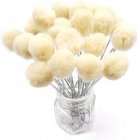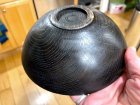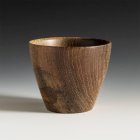Is the liquid supposed to be black in the jar after putting steel wool in vinegar after a couple of weeks? It's taken on a slight greyish tint but still very much clear. I used white vinegar, not cider vinegar. I tried it on a test piece of wood but not much going on there. A bit spilled out and it dried a sort of rusty color. I just expected "black as midnight" instead of "cloudy afternoon".
-
Beware of Counterfeit Woodturning Tools (click here for details) -
Johnathan Silwones is starting a new AAW chapter, Southern Alleghenies Woodturners, in Johnstown, PA. (click here for details) -
Congratulations to Keven Jesequel for "Big Leaf Maple" being selected as Turning of the Week for April 15, 2024 (click here for details) -
Welcome new registering member. Your username must be your real First and Last name (for example: John Doe). "Screen names" and "handles" are not allowed and your registration will be deleted if you don't use your real name. Also, do not use all caps nor all lower case.
You are using an out of date browser. It may not display this or other websites correctly.
You should upgrade or use an alternative browser.
You should upgrade or use an alternative browser.
Ebonizing with vinegar
- Thread starter Tom Hansen
- Start date
What size of steel wool did you use? 0000?
You're making iron oxide, not dye. The chemical reaction with the tannic acid in the wood makes it dark.
Is the liquid supposed to be black in the jar after putting steel wool in vinegar after a couple of weeks? It's taken on a slight greyish tint but still very much clear. I used white vinegar, not cider vinegar. I tried it on a test piece of wood but not much going on there. A bit spilled out and it dried a sort of rusty color. I just expected "black as midnight" instead of "cloudy afternoon".
What type of wood are you testing it on? Unless the wood has tannin in it (such as oak), it won't ebonize as RC said above. If it is a wood low in tannin, you will need to pretreat the wood with a tannin-rich solution, such as quebracho see
https://www.popularwoodworking.com/techniques/ebonizing_wood/
I just expected "black as midnight" instead of "cloudy afternoon".
If you want "black as midnight" you need India ink, dye, or shoe polish.
I've tried steel wool, and rusty nails in cooking vinegar. Got a "cloudy afternoon" on oak and walnut. Multiply coats will get darker. The walnut looked pretty good. The oak sorta looked dirty.
Even if you are using it oak, red oak does not darken nearly as well as white oak. And sapwood will not darken as well as heartwood. Using a tannin-rich wash will greatly increase the color.
- Joined
- Apr 27, 2004
- Messages
- 8,627
- Likes
- 4,955
- Location
- Lakeland, Florida
- Website
- www.hockenberywoodturning.com
I wish you success with vinegar & steel wool in getting the results you are looking for.
If I want something black I use Fiebings USMC black leather dye or airbrush paint.
The leather dye is easy to use and with its long the shelf life a bottle will last you many years.
If I want something black I use Fiebings USMC black leather dye or airbrush paint.
The leather dye is easy to use and with its long the shelf life a bottle will last you many years.
I'm mostly just experimenting at this point. I have zero idea what I'm doing and just wanted to play. I have a lot of boring wood thus the desire to goof with color and texture.
I used 0000 steel wool.
I have no idea what kind of wood it was I tested it on.
If it's an acidic reaction, would green wood produce more black than dry?
I actually have some USMC Fiebings. Hockenbery, do you apply it with airbrush or paintbrush?
I've tried black spirit stain and it wasn't black enough.
Recently tried india ink via Faber-Castell Pitt artist pens. It looks good but this particular application they wouldn't work as I'm wanting to do a large area.
Thanks for all the input, it's greatly appreciated. As a turner that still doesn't know up from down, for the most part, being able to come here and ask questions is a tremendous resource.
I used 0000 steel wool.
I have no idea what kind of wood it was I tested it on.
If it's an acidic reaction, would green wood produce more black than dry?
I actually have some USMC Fiebings. Hockenbery, do you apply it with airbrush or paintbrush?
I've tried black spirit stain and it wasn't black enough.
Recently tried india ink via Faber-Castell Pitt artist pens. It looks good but this particular application they wouldn't work as I'm wanting to do a large area.
Thanks for all the input, it's greatly appreciated. As a turner that still doesn't know up from down, for the most part, being able to come here and ask questions is a tremendous resource.
Dave Landers
Beta Tester
I've tried the steel-in-vinegar method, with and without a black tea pre-wash. I got great results, sometimes. Other times just not even close. Sometimes both results on two pieces of the same wood. I've given up on that.
I currently am happy with the results I get from india ink (not pens, buy a bottle of ink from an art store or amazon). I apply it liberally, with paper towels (wear rubber gloves) until it looks good. Wipe off any drops and let that dry (doesn't take long). The water (or whatever) in the ink usually raises the grain, so I sand that down and re-apply. It looks shiny when it's wet, but dries to a matte or flat black. A gloss finish will bring back the shine (if that's what you're after).
I've also used tiny paint brushes to touch a specific area (I clean those brushes with denatured alcohol).
And I use a tiny bit (a drop or less) mixed into 2-part epoxy to get a black filler.
So I find it pretty handy stuff to have around.
Someday I want to try the Fiebings USMC, see how that compares for the pieces I'm doing, but haven't got around to that yet.
I currently am happy with the results I get from india ink (not pens, buy a bottle of ink from an art store or amazon). I apply it liberally, with paper towels (wear rubber gloves) until it looks good. Wipe off any drops and let that dry (doesn't take long). The water (or whatever) in the ink usually raises the grain, so I sand that down and re-apply. It looks shiny when it's wet, but dries to a matte or flat black. A gloss finish will bring back the shine (if that's what you're after).
I've also used tiny paint brushes to touch a specific area (I clean those brushes with denatured alcohol).
And I use a tiny bit (a drop or less) mixed into 2-part epoxy to get a black filler.
So I find it pretty handy stuff to have around.
Someday I want to try the Fiebings USMC, see how that compares for the pieces I'm doing, but haven't got around to that yet.
- Joined
- Apr 27, 2004
- Messages
- 8,627
- Likes
- 4,955
- Location
- Lakeland, Florida
- Website
- www.hockenberywoodturning.com
have some USMC Fiebings. Hockenbery, do you apply it with airbrush or paintbrush?
I wear nitrile gloves. I usually apply it with a foam brush.
I have air brushed it a few times
I also work with a fan
Tom, the steel wool-vinegar solution that I normally keep on hand generally has a dark reddish color to it. Did the solution you made bubble at all? Is all the steel wool gone? I don't always see bubbling, but it's reassuring when I do. After 3 weeks, the steel wool should be dissolved, although little bits of it will remain suspended in the solution.
Good old Lipton black tea seems to be effective for the tannin supplement. In my experience, repeating the application of the iron solution increases the color a modest amount at most.
On walnut, I get pretty good results, at least results that mimic natural Ebony, which itself is not solidly black black. It will not get to African Blackwood black. Once the finish is on, the black color seems highlighted and more appealing than when it's just been applied. Cherry reacts but doesn't seem to get much more than murky gray, and looks unappealing to me. (If I wanted that color, I could use some catalpa or myrtle I have around here someplace)
Good old Lipton black tea seems to be effective for the tannin supplement. In my experience, repeating the application of the iron solution increases the color a modest amount at most.
On walnut, I get pretty good results, at least results that mimic natural Ebony, which itself is not solidly black black. It will not get to African Blackwood black. Once the finish is on, the black color seems highlighted and more appealing than when it's just been applied. Cherry reacts but doesn't seem to get much more than murky gray, and looks unappealing to me. (If I wanted that color, I could use some catalpa or myrtle I have around here someplace)
I have never been happy with the results I got with the steel wool/vinegar process. Instead I have been using General Finishes Ebony Dye Stain.
It never bubbled whatsoever. It's been in there for at least 3 weeks and all the wool is still there far as I can tell. I remember reading somewhere about a wax coating on some of it that might slow down the process but not this slow. The color has a slight greyish tint. I'll try it again with cider vinegar instead of white.
I do have some walnut that is finish turned waiting for me to decide what to do with it.
I do have some walnut that is finish turned waiting for me to decide what to do with it.
When I first tried this, years ago, following the instructions de jure, soaking rusty nails and steel wool in vinegar, the results were not good. The solution turned oak blackish, but the rust color, and the grayish hue showed thru. For a truer black, I use Speedball India ink, not because it's better than the other inks or dyes but because I'm cheap, it is, according to their website, "highly opaque" with "optimum lightfastness". As for the steel wool and vinegar, I still use that with a few changes. I boil white vinegar with Lebron 0000 steel wool (touted as being oil free) let it cool and strain thru a coffee filter, the resulting mixture is fairly clear. Applied to white oak, the results are almost instant and fairly black, it can be diluted for more control for use in restoration work to "age" new oak.
 32oz, less then 20 bucks.
32oz, less then 20 bucks.
 About 5 to 10 seconds after first application, top is White Oak bottom is red.
About 5 to 10 seconds after first application, top is White Oak bottom is red.
 Four applications over about 1/2 hour, slightly deeper color.
Four applications over about 1/2 hour, slightly deeper color.
 32oz, less then 20 bucks.
32oz, less then 20 bucks. About 5 to 10 seconds after first application, top is White Oak bottom is red.
About 5 to 10 seconds after first application, top is White Oak bottom is red. Four applications over about 1/2 hour, slightly deeper color.
Four applications over about 1/2 hour, slightly deeper color.I have had faster results using steel wool that is already a little rusty before putting it into the vinegar. The solution is ready to use after about a day, and gets a little stronger over the next few days and then starts to get weaker as the steel wool is consumed. After a week or so, it is no longer effective. I only make small, batches, about a quarter cup. I for one like the effect of being grey and not black. Here is an example on spalted maple.
Spalted maple hollow form
I experimented with ebonizing treatment on this one. Some steel wool in white vinegar. If the...
I tried to mix a vinegar/steel wool solution some yrs. ago and got nowhere. I recently found that Walmart carries a cleaning vinegar. This time it is working. Now to get some oak on the lathe.
Im wondering if anyone out there with a chemistry background know if its the ferric ions or the ferrous ions involved in the ebonizing reaction. I have some ferric solutions in my darkroom chems for alt processes but they dont seem to have any activity on wood.
I don't know what factors make a difference, but I put a couple of pieces of 0000 steel wool in a jar full of white vinegar, and after about two weeks or so it was a rusty color and the steel wool was almost completely gone. I've used it a few times, and the effect has been very strong on tannic woods. White oak turned pretty much completely black, and cherry almost black. Hickory got a good bit darker, but nowhere near black. There was what I'd have to call a "blonding" effect on ash!
The first photo is oak and the second is hickory.
The first photo is oak and the second is hickory.
Attachments
Something didn't work right. White vinegar should be fine. Maybe the vinegar you had was old and had lost strength somehow. Rinsing the steel wool in mineral spirits might dewax it. Also, you want a glass jar for the process.It never bubbled whatsoever. It's been in there for at least 3 weeks and all the wool is still there far as I can tell. I remember reading somewhere about a wax coating on some of it that might slow down the process but not this slow. The color has a slight greyish tint. I'll try it again with cider vinegar instead of white.
I do have some walnut that is finish turned waiting for me to decide what to do with it.
As others have mentioned, you don't have to use this method to get stuff black.
I suppose if I had some steel wool my glacial acetic acid will make quick work of it. Nasty stuff to play with though, over twenty times as strong as vinegar.
Tom: had the same experienceas you then I tried it again using very coarse steel wool. the juice started turning black within hours. Coarse wool!I'm mostly just experimenting at this point. I have zero idea what I'm doing and just wanted to play. I have a lot of boring wood thus the desire to goof with color and texture.
I used 0000 steel wool.
I have no idea what kind of wood it was I tested it on.
If it's an acidic reaction, would green wood produce more black than dry?
I actually have some USMC Fiebings. Hockenbery, do you apply it with airbrush or paintbrush?
I've tried black spirit stain and it wasn't black enough.
Recently tried india ink via Faber-Castell Pitt artist pens. It looks good but this particular application they wouldn't work as I'm wanting to do a large area.
Thanks for all the input, it's greatly appreciated. As a turner that still doesn't know up from down, for the most part, being able to come here and ask questions is a tremendous resource.




